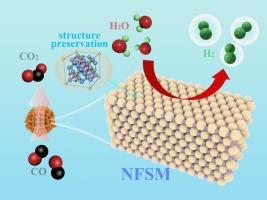Enhanced morphological maintenance and redox stability by dispersing nickel ferrite into silica matrix for chemical looping hydrogen production via water splitting
Abstract
Chemical looping hydrogen production (CLHP) is widely regarded as a clean and efficient route for high purity hydrogen production. However, a huge barrier is how to avoid serious deactivation caused by sintering and agglomeration of oxygen carriers. A novel fabrication process of highly dispersing NiFe2O4 into silica matrix is proposed. The oxygen carriers of NiFe2O4 completely dispersed over silica matrix (NFSM) are successfully synthesized. The characterizations, hydrogen production capacity and cycle redox performance of oxygen carriers are further investigated. The results illustrate that NiFe2O4 active components are homogeneously dispersed on the silica matrix without any impurities. NFSM demonstrates the highest reactivity with CO as well as the greatest hydrogen production of 296 mL/g due to the strong confinement effect of silica matrix and good particle dispersion. The porous silica matrix offers large amounts of channels for the lattice oxygen transport and effectively prevents Fe and Ni cations outward migration to particle surface, which actually inhibits the larger clusters and sintering. NFSM can keep stable hydrogen production of approximately 290 mL/g during the cyclic experiments. Briefly, the innovation method of embedding active component into well-established silica matrix supports contributes to the enhanced anti-sintering properties and redox stability of oxygen carriers.


 求助内容:
求助内容: 应助结果提醒方式:
应助结果提醒方式:


